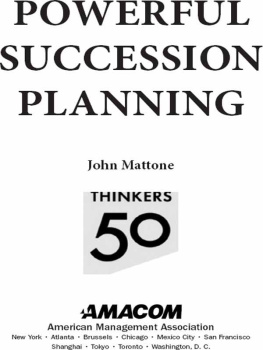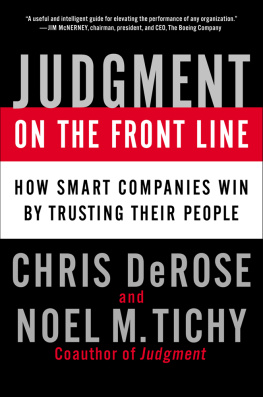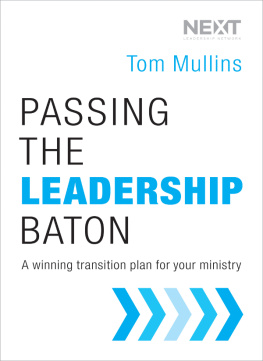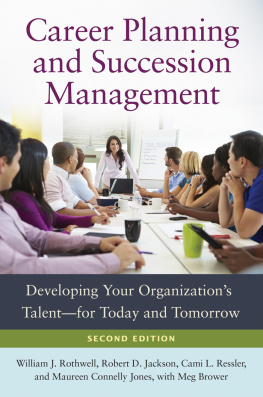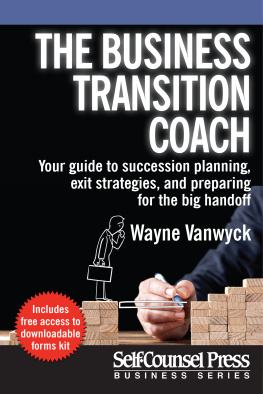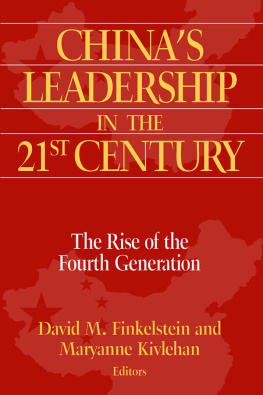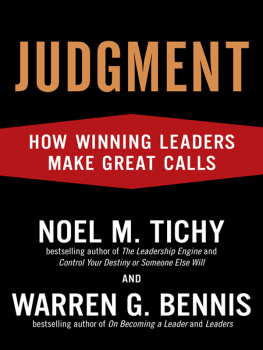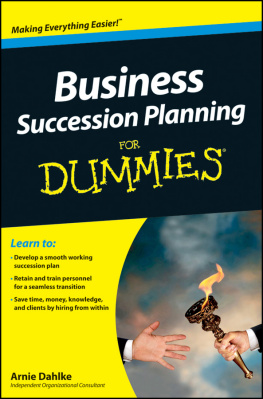Hes seen it all from the inside, and he pulls no punches in showing us the human reality that separates success from failure. This is true wisdom. Learn from the master.
G EOFF C OLVIN , author of Talent Is Overrated, senior editor at large, Fortune
Beware: Noel Tichys Succession may give you nightmares, especially if you are a CEO, CHRO, or board member accountable for a CEO succession. If Tichy succeeds in making people more aware of the risks, opportunities, and nuances of CEO succession, this book will have performed a valuable public service.
S TR ATFORD S HERMAN , partner, Accompli; coauthor of Control Your Destiny or Someone Else Will
If managing a succession is on your horizon or if succession is simply one of your intellectual interests, this book is a page-turner.
M ADELINE H EILMAN , professor of psychology, New York University
Succession draws on Tichys decades of experience working with the leaders of Global 100 firms. He goes beyond simplistic recipes and checklists to introduce the reader to both successful transitions and horrifying failures. Succession planning is among the most important functions for boards and CEOs. Succession is a crash course in this critical, but too often neglected, responsibility.
R OBERT K ENNEDY , dean and L AWRENCE G. T APP Chair in Leadership, Ivey Business School
The most important question for any institution is Who will lead fearlessly? Tichys book provides the answer through the rigorous lens of a long-term practitioner and scholar on leadership and succession. Most get succession wrong. This book will help fearless leaders get it right.
C ATHY G REENBERG , author of Fearless Leaders: Sharpen Your Focus. www.DrCathyGreenberg.com
ALSO COAUTHORED BY NOEL M. TICHY
Judgment on the Front Line: How Smart Companies Win by Trusting Their People
Judgment: How Winning Leaders Make Great Calls
PORTFOLIO / PENGUIN
Published by the Penguin Group
Penguin Group (USA) LLC
375 Hudson Street
New York, New York 10014

USA | Canada | UK | Ireland | Australia | New Zealand | India | South Africa | China
penguin.com
A Penguin Random House Company
First published by Portfolio / Penguin, a member of Penguin Group (USA) LLC, 2014
Copyright 2014 by Noel M. Tichy
Penguin supports copyright. Copyright fuels creativity, encourages diverse voices, promotes free speech, and creates a vibrant culture. Thank you for buying an authorized edition of this book and for complying with copyright laws by not reproducing, scanning, or distributing any part of it in any form without permission. You are supporting writers and allowing Penguin to continue to publish books for every reader.
LIBRARY OF CONGRESS CATALOGING - IN - PUBLICATION DATA
Tichy, Noel M.
Succession : mastering the make or break process of leadership transition / Noel M. Tichy.
pages cm
Includes bibliographical references and index.
eBook ISBN 978-0-698-15166-6
1. Executive succession. 2. Leadership. 3. Management. 4. Organizational effectiveness. I. Title.
HD38.2.T53 2014
658.4'0711dc23
2014022254
This book is dedicated to the true meaning of succession, namely, my ten grandchildren, who will, I hope, all find a way to make the world a little better.
Version_1
CONTENTS
INTRODUCTION
Every question about leadership ultimately gets down to development. Its about creating crucible experiences that make others better as a way of making yourself better. Its about focusing on a task you dont think can be done. Where you are rallying people across cultures and functions, where youre challenged ethically, and where your integrity is going to be tested.
In my experience, you dont go searching for those experiences. They tend to find you. The older you get the more you learn that people decisions are the most difficult. They are emotionally difficult, and they are also the best measure of how well you are doing as a leader.
James McNerney, chairman, president, and CEO, Boeing; lecture at the University of Michigans Ross School of Business
Placing a Big Bet on the Long Game
I have known and worked closely with Jim McNerney, the current CEO of Boeing, since early 1985 when as a senior executive at GE Information Services, popularly known as GEIS, he participated in a series of workshops I was facilitating for his units top team, of which he was a key member. Later that year, after agreeing to head up GEs famed Leadership Development Center at Crotonville in upstate New York, I got to know Jim even better. Over the more than quarter century since, I have closely tracked his career and had an opportunity to both work with and write about him as he moved through multiple business leadership positions inside GEincluding head of Asia Pacific, a senior position in GE Capital, and CEO of both Lighting and Aircraft Enginesbefore being recruited to serve first as CEO of 3M and then chairman and CEO of Boeing.
McNerney and I are both proud products of and participants in the Jack Welch era at GE, so it is only natural that we share a mutual admiration for Welch as an exemplary leader/teacher who developed more leaders than any CEO in modern business history. This was no happy accident, but rather the result of an elaborate process, framework, and infrastructure of talent development, unique to GE, which has more deeply embedded a culture of leadership in the DNA of that organizationboth before and after the Welch erathan any other outfit I know of, whether public or private, for profit or nonprofit. This started with founder Thomas A. Edison, who in 1879 envisioned a company that would light up a nation, through Charles A. Coffin, who started GE on a seemingly permanent path to innovations in technology, management, and leadership and skillfully organized the worlds first true industrial conglomerate over his nearly thirty-year reign from 1892 to 1922. While Coffin created a vertical, hierarchical, centralized structure to control the various GE Works scattered across the country, he conceived of organizing national sales forces along product lines, and established the nations first industrial research laboratory under Charles Proteus Steinmetz, widely known as The Wizard of Schenectady.
But apart from all the patents, inventions, and innovations that GE pioneeredmore than any company in the world over timeits most singular contribution to the evolution of modern business has been the intensity of its focus on leadership. By the 1920s under the duo of Coffins successors Gerard Swope and Owen Young, GE began conducting specialized management retreats in the Thousand Islands area of upstate New York stressing the inculcation of leadership values, the first true corporate leadership curriculum in the world, which served as the precursor to the establishment of the leadership development center at Crotonville in 1956 under then-CEO Ralph Cordiner. The center spearheaded a thirteen-week executive leadership program that would be emulated by Harvard and other leading schools of business as they developed their own leadership programs.
This by-then well-grounded tradition of innovating new business models as well as machines led during the Depression to the foundation of GE Credit (later called GE Capital) to provide struggling householders with the means to buy GEs washing machines, toasters, fans, and other electrical appliances. During that period of the New Deal, as labor relations became a new battlefield, management focused on the adoption of generous pension plans and profit-based bonuses to keep its employees from joining unions. During the postWorld War II period of rapid economic expansion, the company continued to develop its core management and leadership curriculum, commissioning such leading lights as the great Austrian-American consultant and theorist Peter F. Drucker to contribute to its famous Bible-like Blue Books, a series consisting of five volumes of meticulously detailed guidance for GE managers that shaped management theory and practice around the country and the world for decades to come. In the 1960s, GE led the way to strategic planning, while in the 1980s and 1990s under Jack Welch, its warm embrace of such then-cutting-edge leadership development concepts as Work Out, Boundarylessness, and Six Sigma made them an integral part of global management culture.


